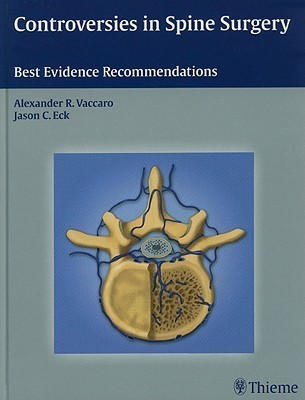Controversies in Spine Surgery 1st Edition(English, Hardcover, unknown)
Quick Overview
Product Price Comparison
Drawing on the expertise of world-renowned orthopedic and neurological spine surgeons, Controversies in Spine Surgery: Best Evidence Recommendations compiles, summarizes, and synthesizes the most relevant scientific literature available in the field today. Each succinct, problem-oriented chapter addresses a different controversial issue where there is a lack of consensus about the best possible course of action. The authors provide guidance and objective recommendations for each scenario based on the most relevant data found in the literature to give surgeons the background they need to make fully informed treatment decisions. Key Features: Concise outline format enables rapid reading for the busy spine surgeon Invaluable synopses of highly practical evidence-based literature Detailed coverage of commonly disputed issues, such as how to manage vertebral compression fractures, surgery for axial back pain, minimally invasive lumbar fusion, the use of prophylactic antibiotics in spine surgery, and much more Grading of Best Evidence feature in which the authors rate the viability of the data presented Numerous summary tables throughout the text emphasize the main conclusions of published studies Pearls highlight important points in each chapter This cutting-edge clinical reference will help every resident, fellow, and spine surgeon in orthopaedic surgery and neurosurgery streamline their medical decision making process and improve their patient care. This is exactly the book one should have ready access to.--American Journal of Neuroradiology All providers who care for patients with spinal problems should consider using this book to help with decision making for their patients on an everyday basis.--Journal of Neurosurgery Table of Contents Preface Contributors Section I Introduction 1 Introduction to Best Evidence Medicine Section II Trauma CERVICAL SPINE 2 Clearing Cervical Spine Injuries: MRI, Dynamic X-rays, CT 3 Type II Odontoid Fractures: Operative versus Nonoperative Management 4 Management of Cervical Facet Fractures: Surgical Indications and Approach 5 Management of Cervical Facet Dislocations: Role of Magnetic Resonance Imaging 6 Management of Cervical Facet Dislocations: Timing of Reduction 7 Management of Cervical Facet Dislocations: Anterior versus Posterior Approach THORACOLUMBAR SPINE 8 Thoracolumbar Burst Fracture: Surgery versus Conservative Care 9 Vertebral Compression Fractures: Percutaneous Vertebral Augmentation SPINAL CORD INJURY 10 Use of Steroids for Spinal Cord Injury 11 Role of Early Surgical Decompression for Spinal Cord Injury Section III Degenerative CERVICAL SPINE 12 Cervical Myelopathy: Anterior versus Posterior Approach 13 Cervical Myelopathy: Timing of Surgery 14 Cervical Myelopathy: Meaning of Magnetic Resonance Imaging Signal Changes 15 Avoidance of Cervical Adjacent Segment Disease THORACOLUMBAR SPINE 16 Adult Low-Grade Spondylolisthesis: Conservative Treatment versus Surgery 17 Adult Low-Grade Spondylolisthesis: Surgical Approach, Role of Fusion, Role of Instrumentation 18 Adult High-Grade Spondylolisthesis: Role of Reduction versus Fusion In Situ 19 Surgery for Axial Back Pain: ALIF versus PLIF or TLIF 20 Recurrent Lumbar Disk Herniation: Repeat Diskectomy versus Fusion 21 Management of Thoracic Disk Herniation Section IV Technology 22 Rigid versus Dynamic Cervical Plates: Indications and Efficacy 23 Bone Morphogenetic Protein in the Cervical Spine: Efficacy and Associated Risks 24 Role of Cervical Disk Replacement: Does It Avoid the Shortcomings of a Fusion? 25 Role of Lumbar Disk Replacement: Does It Avoid the Shortcomings of a Fusion? 26 Minimally Invasive Lumbar Fusion: Results and Complications Compared with Open Techniques 27 Magnetic Resonance Imaging Findings of Posterior Ligamentous Injury Section V Infection 28 Bone Morphogenetic Protein in the Setting of Infection: Indications, Risks, and Efficacy 29 Spine Infections: Medical versus Surgical Treatment Options 30 Use of Prophylactic Antibiotics in Spine Surgery Index


